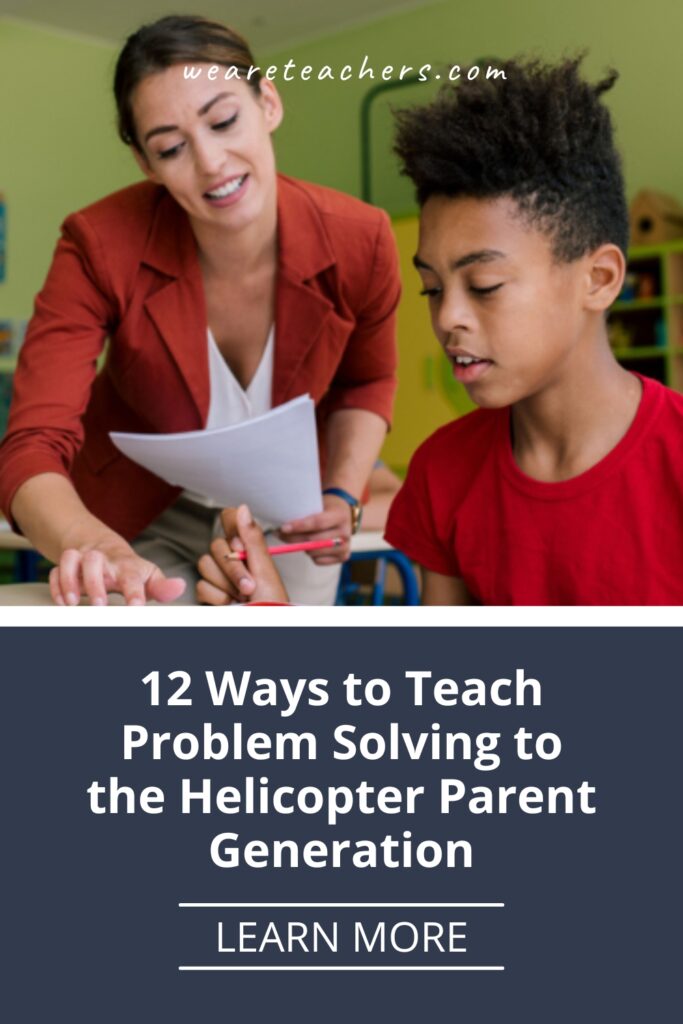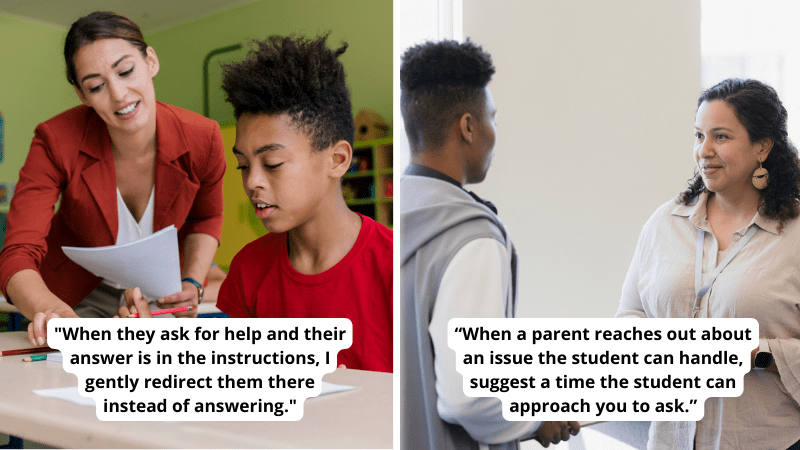I will never forget the time a student informed me there was a Cheeto under his desk. Since this was probably the thousandth time this student informed me of problems instead of taking steps to solve them himself, I prompted him to take the initiative.
“Hmm. I wonder what you could do about that Cheeto.”
He stared at me like I was speaking a language he didn’t know.
After a lot of back and forth about possible solutions to the errant snack that didn’t involve me solving the problem, he finally picked up the Cheeto with a tissue and disposed of it. It wasn’t my first encounter with learned helplessness as a teacher, but it shook me to my core.
Teachers of all subjects and ages have their own Cheeto moments. And between the helicopter, lawnmower, and jackhammer parents of today, it’s no wonder that many kids don’t know what to do when faced with even the smallest road bumps in the classroom. As teachers have taken notice of this trend, they’ve developed strategies to help students shake off their learned helplessness and become Cheeto disposers instead of Cheeto despairers.
Some teachers have sayings, some have procedures, and others embed self-advocacy into their lessons. Here’s what our teacher audience said they practice in their classrooms:
“I think it starts in the early years.”
“I teach primary grades and have students unpack their folders and bring me things that need to be turned in. They learn it’s OK and expected to ask for help. Modeling making mistakes and asking for help to fix them. As a parent, I talk my sons through asking for help, writing emails, and such.”
—Lori F.
“When a parent reaches out about an issue the student can handle, use this as an opportunity.”
“Say, ‘Have Johnny ask me in the morning and I will help him out.’”
—Amy M.
“I tell students to document.”
“Use their resources to create an argument so that when they advocate for themselves they have evidence.”
—Vicki L.
“Sign them up for debate.”
“Also teach oratory and public speaking and debate in every class.”
—Leeann S.
“I think teaching them how to problem-solve is key.”
“If they need a pair of scissors, they should know where to find another pair and solve the problem. In my (K) class, they do not have to ask to get a drink of water or go to the bathroom. They simply do what they need to do without interrupting the lessons. They have learned to ask for help when they are sick or hurt, but other situations they are learning to figure out on their own. We use ‘Ask a friend,’ ‘How can you solve that problem?,’ ‘Use your words,’ and ‘Where can you find that answer?’”
—Jennifer K.
“In first/second grade, I frequently used the phrase, ‘I can’t help you until you tell me what you need.’”
“This was used to help students understand that I’m not a mind reader but want to support them however I can. At the beginning of the year, I would introduce the phrase and we would talk about what it meant. I would offer some suggestions for what they might need (a walk to get water, to breathe, to take a break for a minute) but always emphasized that the students themselves often know best what they need. Over the year, students slowly understood this concept more and more and were more prepared to explain what they needed when they came to me with a problem.”
—Emily A.
“For my middle school students, I use ‘Ask three, then ask me.’”
“I noticed that I was having a lot of students shout out simple questions during class time that interrupted me while working with other students. So for non-emergencies like questions about instructions or classwork, I tell students they need to first ask three of their classmates their question before they can ask me. This tremendously cut down on learned helplessness and helps students see their peers as resources in learning.”
—Sadie M.
“I make students ask for what they need.”
“They quickly learn that if they tell me ‘I can’t find a pencil,’ I’ll respond with ‘Thanks for letting me know’ and go back to what I was doing, or I’ll say, ‘Did you just want me to know that?’ If they say yes, I move on. If they ask for a pencil, however, I will gladly give them one. If they need help, they can’t just say, ‘This is hard.’ If they are looking for missing work, they can’t just tell me they are having a hard time finding it. I make them say, ‘Will you help me?’ or ‘Can I have another pencil?’ and so on. It helps them learn to ask for what they need instead of just expecting someone else to solve their problem.”
—Rachel S.
“With lots of practice …”
“… a safe place to make mistakes, praise when they tell me what they need, thanking them when they let me know that something is off but they aren’t sure what, being encouraging, giving them the words to use, practicing how to ask appropriately after meltdowns are over and behind us, giving them the steps, and working with their parents to do the same!”
—Laura S.
“Teach them about the Universal Rights of the Child!”
—Meg A.
“K teacher … I teach them 2 phrases to say to someone that’s doing something they don’t like: I don’t like it when you ________. Please don’t _________.”
“They should say it twice before coming to me for help. (I say that if they keep doing it after being asked twice, then that’s disrespectful and I’ll help them handle that.) Another thing … when they see someone struggling with something, they should ask them, ‘Do you need some help?’”
—Eron B.
“I embed executive function skills within my lesson.”
“For example, we were highlighting compound sentences within a paragraph, presented in slides. Slide 1 had a review of simple vs. compound sentences. Slide 2 was practice, with the direction to highlight sentences green. If they forgot what types were, I directed them to slide one. When they highlighted things purple or made them bold, I redirected them to the instructions. I remind them I will always help, but they need to try to help themselves first.”
—Kelly K.
How do you teach problem-solving in your classroom? Let us know in the comments.
Looking for more articles like this? Be sure to subscribe to our newsletters!


